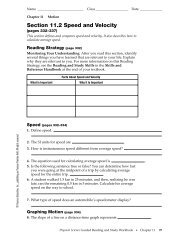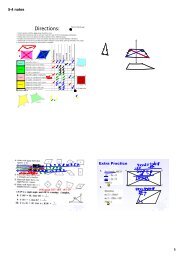Study Guide 18.1 - Barrington High School
Study Guide 18.1 - Barrington High School
Study Guide 18.1 - Barrington High School
Create successful ePaper yourself
Turn your PDF publications into a flip-book with our unique Google optimized e-Paper software.
Name ___________________________ Class ___________________ Date _____________<br />
Chapter 18<br />
The Electromagnetic Spectrum and Light<br />
Section <strong>18.1</strong> Electromagnetic Waves<br />
(pages 532–538)<br />
This section describes the characteristics of electromagnetic waves.<br />
Reading Strategy (page 532)<br />
Comparing and Contrasting As you read about electromagnetic<br />
waves, fill in the table below. If the characteristic listed in the table<br />
describes electromagnetic waves, write E in the column for Wave Type.<br />
Write M for mechanical waves and B for both. For more information on<br />
this Reading Strategy, see the Reading and <strong>Study</strong> Skills in the Skills<br />
and Reference Handbook at the end of your textbook.<br />
Electromagnetic and Mechanical Waves<br />
Travels through a vacuum<br />
E<br />
Travels though medium<br />
Fits wave model<br />
B<br />
Fits particle model<br />
E<br />
Transverse wave<br />
B<br />
Longitudinal wave<br />
M<br />
What Are Electromagnetic Waves? (page 533)<br />
1. What are electromagnetic waves?<br />
© Pearson Education, Inc., publishing as Pearson Prentice Hall. All rights reserved.<br />
2. Electric fields are produced by electrically charged particles and by<br />
changing .<br />
3. Magnetic fields are produced by magnets, by changing<br />
, and by vibrating charges.<br />
4. Electromagnetic waves are produced when a(n)<br />
vibrates or accelerates.<br />
5. Circle the letter of each sentence that is true about electric and<br />
magnetic fields.<br />
a. An electromagnetic wave occurs when electric and magnetic<br />
fields vibrate at right angles to each other.<br />
b. A magnetic field is surrounded by an electric current.<br />
c. Changing electric and magnetic fields regenerate each other.<br />
d. Electromagnetic waves are produced when an electric<br />
charge vibrates.<br />
6. Is the following sentence true or false? Electromagnetic waves need<br />
a medium to travel through.<br />
7. The transfer of energy by electromagnetic waves traveling through<br />
matter or across space is called .<br />
Physical Science <strong>Guide</strong>d Reading and <strong>Study</strong> Workbook ■ Chapter 18 157
Name ___________________________ Class ___________________ Date _____________<br />
Chapter 18<br />
The Electromagnetic Spectrum and Light<br />
The Speed of Electromagnetic Waves (page 534)<br />
8. As a thunderstorm approaches, you see the lightning before<br />
you hear the thunder, because light travels<br />
than sound.<br />
9. Is the following sentence true or false? All electromagnetic waves<br />
travel at the same speed through a vacuum.<br />
10. Circle the letter that gives the correct speed of light in a vacuum.<br />
a. 3.00 10 8 kilometers per second<br />
b. 3.00 10 8 meters per hour<br />
c. 3.00 10 8 meters per second<br />
d. 3.00 10 8 kilometers per hour<br />
Wavelength and Frequency (page 535)<br />
11. Circle the letter of each sentence that is true about<br />
electromagnetic waves.<br />
a. Different electromagnetic waves can have different frequencies.<br />
b. Wavelength is directly proportional to frequency.<br />
c. Electromagnetic waves always travel at the speed of light.<br />
d. All electromagnetic waves travel at the same speed in<br />
a vacuum.<br />
12. As the wavelengths of electromagnetic waves increase,<br />
the frequencies<br />
, for waves moving<br />
in a(n) .<br />
Wave or Particle? (pages 536–537)<br />
13. Electromagnetic radiation behaves sometimes like a(n)<br />
and sometimes like a stream<br />
of .<br />
14. Interference only occurs when two or more waves overlap, so<br />
experiment showed that light behaves<br />
like a .<br />
15. The emission of electrons from a metal caused by light striking the<br />
metal is called the<br />
effect.<br />
16. Blue light has a higher frequency than red light, so photons of blue<br />
light have<br />
energy than photons of red light.<br />
Intensity (page 538)<br />
17. The closer you get to a source of light, the<br />
the light appears.<br />
18. Intensity is the at which a wave’s energy<br />
flows through a given unit of area.<br />
19. As photons travel farther from the source, the<br />
of light decreases.<br />
© Pearson Education, Inc., publishing as Pearson Prentice Hall. All rights reserved.<br />
158 Physical Science <strong>Guide</strong>d Reading and <strong>Study</strong> Workbook ■ Chapter 18




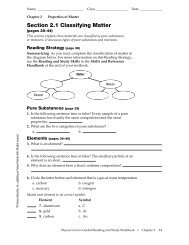
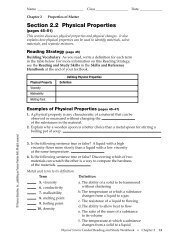
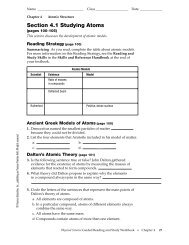

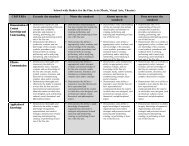
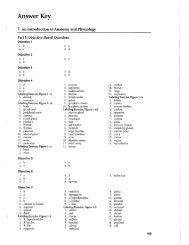
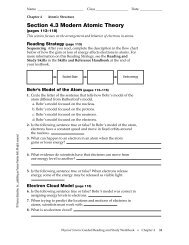
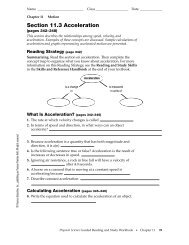
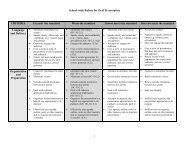
![Nov1-3 [Laurie Garland] - The Charles A. Dana Center](https://img.yumpu.com/26208999/1/190x146/nov1-3-laurie-garland-the-charles-a-dana-center.jpg?quality=85)

